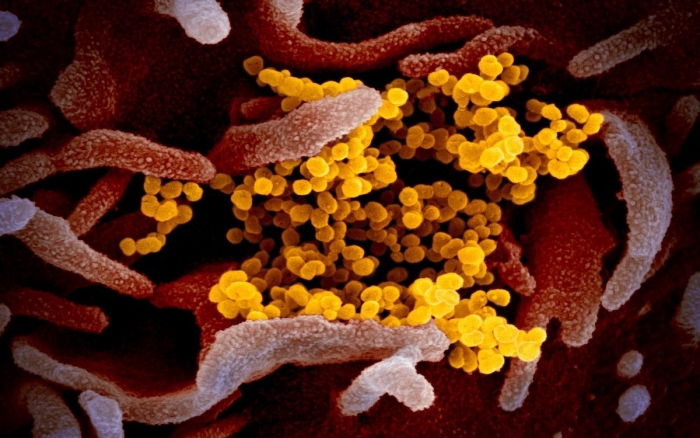As the COVID-19 (coronavirus) pandemic continues, physicians and medical researchers are facing questions about newly recognized symptoms, antibody testing and what the public can expect in the near future.
Some also have expressed concern for the health of protestors who have been gathering in large numbers to decry racial injustice in America.
“Unfortunately, as pandemic conditions continue, so does the possibility of becoming infected with COVID-19 if you’re in close contact with others who may be infected,” said infectious disease specialist Rekha Murthy, MD, vice president of medical affairs and associate chief medical officer at Cedars-Sinai.
While large gatherings still are not recommended from a public health perspective, Murthy advised that if individuals find themselves in such a situation, they should follow established safety measures to avoid a COVID-19 infection: wearing a mask, frequent hand hygiene and maintaining physical distance from others.

Protestors should be aware of and protect themselves from the personal health risks they face as they rightfully protest other risk factors of systemic racism leading to health inequities, Murthy said. Aggressive policing, brutality and injustice, poverty, employment discrimination and lack of access to health care all contribute directly to the public’s health.
According to the nonprofit APM Research Lab, emerging data regarding COVID-19 mortality reveals deep inequities by race, most dramatically for African Americans. The COVID-19 mortality rate for African Americans is 2.4 times as high as the rate for whites and 2.2 times as high as the rate for Latino and Asian Americans.
“At Cedars-Sinai, we are working hard to enable and achieve health equity for all,” Murthy said.
The Newsroom spoke with Murthy and infectious disease specialist Michael Ben-Aderet, MD, associate director of Hospital Epidemiology at Cedars-Sinai, for the latest on what we know about COVID-19 and how the public – including protesters – can protect themselves.
If you have COVID-19 but don’t have symptoms, can you still put others at risk of catching the virus?
Yes. The incubation period for COVID-19, which is the time between exposure to the virus (becoming infected) and symptom onset, is on average five to six days, but it can be up to 14 days. During this period, also known as the “pre-symptomatic” period, some infected persons can be contagious. Therefore, transmission from a pre-symptomatic case can occur before symptom onset. These facts support the recommendation by experts for the use of face masks by the general public when in crowded outdoor or indoor spaces to control spread of COVID-19. Public health officials advise protesters to monitor for symptoms for two weeks after attending a large public event.
How long does the infection last?
With COVID-19, there’s a wide spectrum ranging from mild respiratory illness to fatal disease, with everything in between. The majority (80%) of people with infection have mild illness and recover. People with moderate or severe clinical illness tend to be sick for a couple of weeks. Though you may be able to detect viral particles in the respiratory secretions of a previously infected patient for several weeks after they’ve recovered, the risk of transmitting infection to others is highest during the first week of illness.
Is there anything unique about the course of the infection?
Patients can have about five to eight days of a mild feverish illness, and if their condition is going to worsen, it happens very rapidly. That’s a unique aspect of COVID-19 and a big challenge because this illness tends to linger in a mild state before worsening. It can catch patients off guard, which means they have to keep a close eye on their symptoms for up to two weeks. In addition, some people may have other symptoms unrelated to respiratory illness early in the course, such as fatigue, sore throat, loss of taste or smell, diarrhea or headache.
How can you tell if your cough is related to COVID-19 versus something like seasonal allergies?
Symptoms of allergies like hay fever tend to be subtle and persistent. Symptoms of a viral illness like influenza or COVID-19 tend to be more severe and accompanied by multiple symptoms, such as a cough that progressively gets worse and a fever, which would not be associated with seasonal allergies.
What is current treatment advice?
Treatment guidance is rapidly evolving due to active research. For mild illness outside of the hospital, it’s still supportive care to manage symptoms. Inside the hospital, we have amazing teams investigating all possible therapies and swiftly enrolling patients in clinical trials. There are some very promising trials happening at Cedars-Sinai and elsewhere, including new antiviral medications and donated plasma.
Will the spread of COVID-19 lessen during hot summer months?
The short answer is, we don’t know. In general, we would not expect summer to be a real cure for this. We’ve seen significant spread during the summer in South America, South Africa, Australia and Southeast Asia. We wouldn’t make the assumption that summer will change things. This is a new pathogen, and we don’t know how it will behave.
Could COVID-19 become a seasonal virus?
It’s too early to tell. We don’t truly understand why influenza is seasonal. Many of the viruses we experience are seasonal, even in areas that do not have severe winters. That science is poorly understood, and we don’t know where COVID-19 will fit in.
Should people wear a mask in public?
Currently, wearing a cloth face covering is a key component in the public health approach to ending stay-at-home orders and allowing us to return to a more normal kind of life. It helps reduce the virus’s ability to spread to others, including those with and without symptoms. The focus is on flattening the curve through continued public health measures including social distancing and good hand hygiene.
Do smokers and vapers run a higher risk of getting COVID-19 or a worse infection?
While we don’t have a large population of smokers and vapers at our hospital, it’s been well reported that they suffer worse outcomes from documented cases in other places. They also suffer worse outcomes from many respiratory viruses such as influenza. Smoking impairs your ability to have an immune response in your lungs. If you’re doing anything that damages your lungs, it puts you at risk for further damage.
As stay-at-home restrictions start to lift, how do we keep ourselves safe?
We need to continue practicing the same measures that we’ve adopted during this pandemic: performing frequent hand hygiene, avoiding people who are symptomatic with respiratory illness, avoiding touching your face and surfaces, covering your cough and being careful when coming into contact with large numbers of people.
How will our lives continue to be different?
This pandemic is going to have a lasting effect on our society. People are now cognizant of how viral illness spreads, and COVID-19 is not the only viral illness out there. We expect there will be a heightened awareness of infectious disease risk, hesitancy around large gatherings and tight quarters in places such as airplanes and more skepticism of people being really close together in general.








